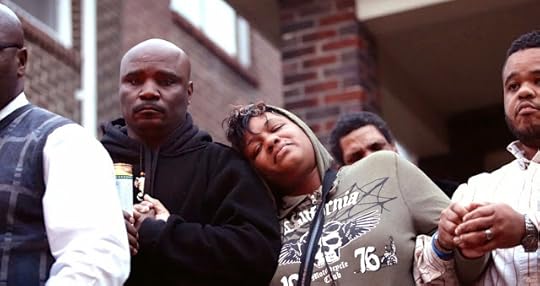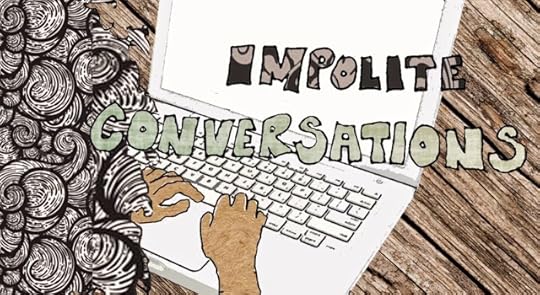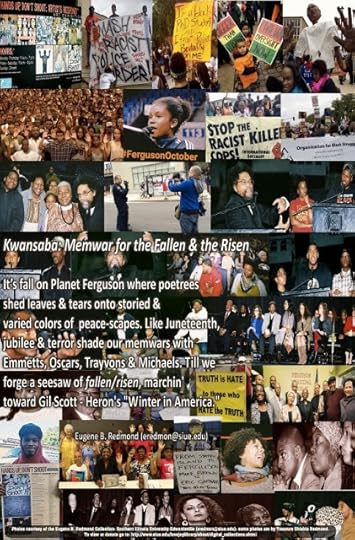Mark Anthony Neal's Blog, page 779
November 14, 2014
Remembering Historian and Civil Rights Activist Vincent Harding
 The Root
The Root
In a preview of the next Left of Black host Mark Anthony Neal talks with historian Derrick White (@blackstar1906) about his memories of the late scholar and activist, Vincent Harding. White is a visiting associate professor of History at Dartmouth College and the author of The Challenge of Blackness: The Institute of the Black World and Political Activism in the 1970s .
Published on November 14, 2014 08:30
November 13, 2014
#SpotlightOnFerguson--The Virtual Freedom School
 Katina Parker
Katina Parker
Mike Brown. Eric Garner. VonDerrit Myers, Jr. Oscar Grant. Sean Bell. The many thousands of names we don't even know. Their families. Their grieving families. We are living in a police state. Each of us. The "safety" we may have carved out for ourselves as adults does not extend itself to our children.#Justice4MikeBrown #Justice4Vonderrit #SpotlightOnFerguson #BlackLivesMatterTo keep the spotlight on police brutality, donate $5 or more: igg.me/at/dontshoot
Published on November 13, 2014 09:38
"Stealing Daddy: Love Notes" by Mark Anthony Neal
 Stealing Daddy: Love Notes
by Mark Anthony Neal | NewBlackMan (in Exile)
Stealing Daddy: Love Notes
by Mark Anthony Neal | NewBlackMan (in Exile)“it’s never been easy with this one--from the beginning.
That she has always been so independent--her big sister at 5 asking what she could have for breakfast, while the barely talking, just started walking toddler goes in the fridge and takes the very yogurt that her sister was asking permission for--or that she has been so self-assured; in quiet private moments, The Woman and I refer to her as the Sophia, of Alice Walker’s imagination.
It took me some time to understand that what she most wanted was my attention. And what that’s really about--for a girl, who is a little shy and would like to be more self-contained than her peers and her hearty personality will ever allow--is having the permission to just climb into her head; when that fails she climbs into mine.
We have spent a lifetime (hers) of red traffic lights talking about God, the afterlife, science, gender expectations, and every other matter that you’d rather not talk about while trying sedate on that NPR pablum.
These days she’s taken to jacking my tee-shirts: that Negro League one, that one with the spilt photo of Travon and Emmett (recalling another traffic light salon), the Tupac one I got from the Hip-Hop Archive back in ‘03, and she made a move for the brand new ‘Miles Ahead’ joint; I can’t wait ‘till she starts stealing my books.”
Published on November 13, 2014 06:44
Zeynep Tufekci and Negar Mottahedeh Talk YouTube, Net Neutrality & Social Movements
 ISLAMiCommentary | Julie Poucher Harbin
ISLAMiCommentary | Julie Poucher Harbin
Zeynep Tufekci, Assistant Professor at UNC-Chapel Hill’s School of Information and Library Science, was the guest speaker at a public talk at Duke University last week — “Algorithms and #Ferguson, The New Gatekeepers.” The talk was geared toward students in Duke professor Negar Mottahedeh’s Social Movements and Social Media seminar, Mottahedeh’s #Selfie seminar, and the Cultures of New Media course taught by Duke anthropologist Rebecca Stein.This particular audio clip (below) from the talk includes observations on the 2009 Iranian election protests, the Arab Spring, ISIS and the Syria Civil war. Mottahedeh asks: “How has YouTube been affected by social movements and does it have algorithms that support or disengage from the activities of social movements?”
Published on November 13, 2014 05:33
November 12, 2014
Chicago Winds…: The Return of Dave Hollister by Mark Anthony Neal
 Chicago Winds…: The Return of Dave Hollisterby Mark Anthony Neal | @NewBlackMan | NewBlackMan (in Exile)
Chicago Winds…: The Return of Dave Hollisterby Mark Anthony Neal | @NewBlackMan | NewBlackMan (in Exile)
“Jesus picked up the pieces | of my broken heart | He made me a new vessel | he revived my soul again” -- “The Broken Vessel” | “The Potter”
For Dave Hollister the devil at the crossroads was neither myth nor function; the demons were real when Hollister, the former lead singer of Blackstreet and one-time heir to the Chi-Town Soul Throne stepped away from the music that made him a star. He found the Lord; a well worn story for those who dared sing at the altars of flesh and ego with voices ordained by Gods we still don’t really know.
And like Rev. Green and Rev. Simon (who was “Drowning in a Sea of Love”) before him, the rhythms and melodies stayed the same – Warren “Baby Dubb” Campbell provided Hollister with a few them on his Gospel debut The Book of David, Vol. 1: The Transition (2006). Healed—spiritually and physically—Hollister returns to the world with Chicago Winds...The Saga Continues, his first secular recording in a decade.
Chicago Winds… feels like a true reboot—not only moving past Hollister’s two Gospel recordings (and a stint in the Fred Hammond led super group United Tenors) but also Things in the Game Done Changed (2002) and Real Talk (2003). If Hollister’s Chicago ‘85: The Movie found him at his artistic peak—he intended the album to be part of a trilogy—Chicago Winds… is a worthy sequel, perhaps reminding folk that Hollister might just be the most talented Soul Man vocalist to emerge from The Chi in the last generation.
For those who can remember the sinister groove that opens Hollister’s “Baby Mama Drama,” the singer was perfectly suited for boom-bap audiences who liked their R&B singers on the thuggish-side. Like Hollister himself asserted: “back on Blackstreet shit was sweet, so now I’m so-lo(w).” Where Robert Sylvester’s musical persona was more brown sugar than brown liquor and Raheem DeVaughn and Jaheim a little too pretty to be taken seriously as corner boys--and them Hailey boys off-pitch and out-of-control--Hollister gave the clearest indication of how Donny Hathaway or any of the Soul Man titans might have flowed had they competed sonically with the boom-bap.
And it was not simply about Hollister’s sartorial choices (check the cover his solo debut Ghetto Hymns); few of Hollister’s peers have been as attuned to the nuances of string and background vocal arrangements, save Robert Sylvester, Eric Benet and Ms. Ndgeocello. It is attention to those details that mark Chicago Winds... as a classic Dave Hollister recording, starting with the opening track “Spend the Night” which harkens to Hollister’s lead on Blackstreet’s “Before I Let You Go.” (and to bring it full circle, Chicago Winds… features a remix of “Spend the Night” from Teddy Riley)
If there is a theme throughout Chicago Winds…, implicit in Hollister’s return, is that these are the musings of a grown man seeking redemption and perhaps forgiveness. To be sure, whatever Hollister’s sins, they were overshadowed by that other well-known Chicago Soul son, yet Hollister’s music gets at the sacrifices and missed opportunities that only a lived adulthood can measure. Listening to the title track “Chicago Winds,” where Hollister owns his absenteeism as a father—and perhaps as an artist—one finds a man both at peace with his mistakes and confronting the limits of who he is, even with the second sight of age and maturity.
Chicago Winds… might be safe—in the way that the programmers for Tom Joyner and D.L. Hughley might find safe (and in contrast to compelling crossroads narratives from August Alsina)—but it is also honest—both to Hollister’s art and the traditions that have produced him.
Published on November 12, 2014 13:47
November 11, 2014
James Earl Jones: From Stutterer To Janitor To Broadway Star
Published on November 11, 2014 20:08
Impolite Conversations--The Series: Episode 1--"Dissed"
 Impolite Conversations: The Series
Impolite Conversations: The Series
Impolite Conversations: The Series is a meta-ethno-non/fictional representation of the conversations that the authors Cora Daniels and John L. Jackson, Jr. had during the process of writing and publishing their book, Impolite Conversations (Atria, 2014).
Published on November 11, 2014 16:59
'The First Sweet Music' -- Curated by Rich Blint | John and June Allcott Gallery | UNC
 David Hammons, Untitled, (circa 1986), Private CollectionThe First Sweet MusicCurated by Rich BlintFeaturing the work of David Hammons, Diedra Harris-Kelley, Lonnie Holley, Jayson Keeling, and Jacolby Satterwhite John and June Allcott Gallery | UNC
David Hammons, Untitled, (circa 1986), Private CollectionThe First Sweet MusicCurated by Rich BlintFeaturing the work of David Hammons, Diedra Harris-Kelley, Lonnie Holley, Jayson Keeling, and Jacolby Satterwhite John and June Allcott Gallery | UNC 13 November-12 December 2014Opening Reception: 13 November 2014, 6-8 pm
"Then of a sudden up from the darkness came music. It was human music, but of a wildness and a weirdness that startled the boy as it fluttered and danced across the dull red waters of the swamp. He hesitated, then impelled by some strange power, left the highway and slipped into the forest of the swamp, shrinking, yet following the song hungrily and half forgetting his fear. A harsher, shriller note struck in as of many and ruder voices; but above it flew the first sweet music, birdlike, abandoned, and the boy crept closer."W.E.B. Dubois, The Quest for the Silver Fleece (1911)
Under the press of enduring asymmetrical arrangements in global life, visual representations of black Atlantic experience in contemporary art have been preoccupied with scenes of historical slight and modern re-castings of the brutal encounter of subjects throughout the diaspora with the habits of power ordering Western society. Through fantastical re-stagings, strategies of inversion, to expressions of radical self-fashioning and other aesthetic conceits, black artists of the New World south have embraced the convention of “imaging back” to empire—a mode of visual address that has largely proven fertile expressive ground. The First Sweet Music, an exhibition of five cross-generational artists working in photography, painting, sculpture, and video, offers flashes of the “black ecstatic” as another way into this fraught and dense visual terrain, presenting works as a way of orienting the viewer’s gaze to the beauty, grace, and true drama that propels and sustains the heroic activity of human living under the vulgarity of protracted subjugation. Echoing Toni Morrison’s invitation in the opening pages of her novel Sula to the insurance collector descending on a struggling community of the newly free, the exhibition is a metaphorical injunction to “stand in the back of Greater Saint Matthews Church and let the tenor’s voice dress [you] in silk” in order to see and get “closer” to the higher (or lower) “birdlike” frequencies resonant with the forces that are much of the substance of black survival.
Lonnie Holley’s Gabriel’s Horn (2011) is such a heralding. Thoughtfully mixed in media, this sculpture of found and seemingly disparate objects utilizes the biblical and almost didactic clarity of the horn that crowns it to underscore the need to disturb the slumber in American life concerning the arrested and dangerous state of our democratic project. David Hammons’ untitled sculpture of Venetian blinds (circa 1986) answers this call across time, space, and form in his dramatically elegant and emotionally incisive re-purposing of this everyday material signifying sight and blindness in a time of desperate urban neglect punctuated by crime, drug abuse, and the overall dispiriting loss of human life and energy. Diedra Harris-Kelley’s remarkably successful paintings are studies in abstract and figurative rapture. Depicting the artist laboring with the imaginative in her studio (haunted and aided by “demons” and ancestors), and an open-mouthed, wide-eyed figure with horns for hair, these works startle with a mature interiority. Through his photographs, Jayson Keeling pairs well with Harris-Kelley. Thoughts and Visions of a Severed Head (Whisper) (2012), an archival inkjet pigment print of a cast of the artist’s head produced by John Ahearn, is a contemporary riff on the 1853 short story by the Belgian painter, Antonie Wertz, which details the slow, painful death of a beheaded man. Keeling’s appropriated self-portrait contemporizes Wertz’s critique of the rise of capital punishment, relating it to a severed black body politic represented here not simply as the dead and gone, but the quietly powerful, with light radiating from the top of the head and those blinding eyes—to say nothing of the purse of the mouth and spiritual quality of the whisper. Jacolby Satterwhite’s Reifying Desire 6 (2014) once again extends the artist’s studied pursuit of what he identifies as infinite visual possibility. For him, “visual restraint lies within my body of archives ranging from collected movements by myself and other performers, my mother’s drawings...Merging them together into a dense crystal of information results in the reification of process, a concrete time-based visual system bleeding formal, philosophical, and political ideas”. Like the boy in Dubois’ century-year-old novel, these artists are not fearful of the more dissonant notes that attend corporeal “blackness” and seek to draw closer to a visual vocabulary that renders the existentiality, the “inside thing” of life down here below legible and endlessly seductive.
Published on November 11, 2014 14:27
Kwansaba: Memwar for the Fallen & the Risen by Eugene B. Redmond
 Kwansaba: Memwar for the Fallen & the Risen
Kwansaba: Memwar for the Fallen & the Risen
It's fall on Planet Ferguson where poetrees
shed leaves & tears onto storied &
varied colors of peace-scapes. Like Juneteenth,
jubilee & terror shade our memwars with
Emmetts, Oscars, Trayvons & Michaels. Till we
forge a seesaw of fallen/risen, marchin'
toward Gil Scott-Heron's "Winter in America."
Eugene B. Redmond (eredmon@siue.edu)
Poet laureate of East Saint Louis, Illinois - October 21, 2014
Published on November 11, 2014 08:56
'Sweet Tea'--The Documentary (Teaser)
 Camra
Camra
Sweet Tea , a feature-length experimental/ethnographic documentary, follows the personal and scholarly trajectory of researcher and activist E. Patrick Johnson . Johnson (the first Black man from his small town of Hickory, North Carolina, to earn a PhD) uses social scientific and humanistic methods to examine questions of identity and community in contemporary society. As someone who has documented his own coming-out story, Johnson also seeks to understand the many different experiences of Black gay men from the South and to share their stories with audiences through both scholarly and artistic means.The film, much like Johnson’s work itself, attempts to transcend conventional assumptions about what counts as “scholarship”—and to reimagine how such scholarship can/should be shared. How do we represent portions of other people’s life stories? How do those stories impact us as researchers and viewers? What does it even mean to blur the boundaries between art and science, scholarship and activism, and what’s to be gained from doing so? Sweet Tea, the film, attempts to place these interconnected themes and questions in critical and creative conversation.
Published on November 11, 2014 05:38
Mark Anthony Neal's Blog
- Mark Anthony Neal's profile
- 30 followers
Mark Anthony Neal isn't a Goodreads Author
(yet),
but they
do have a blog,
so here are some recent posts imported from
their feed.




